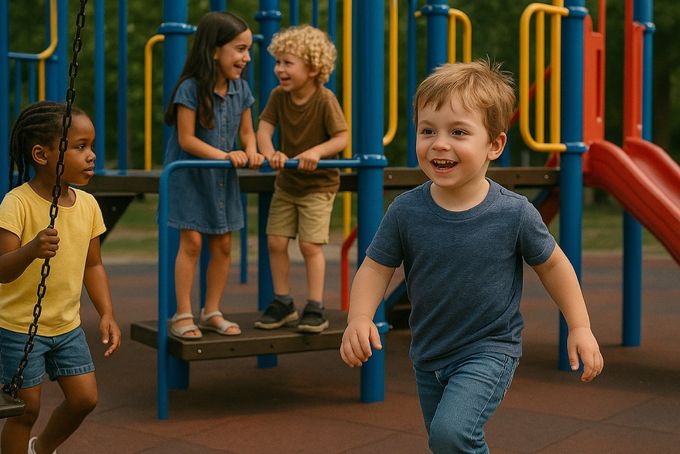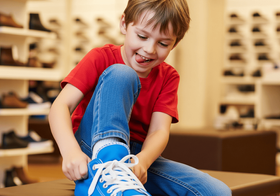Why Outdoor Play Is Crucial for Your Child's Development
Lack of outdoor time is linked to obesity, myopia, and delayed communication. Encouraging outdoor play supports every stage of child development—motor skills, attention, emotional regulation, and social growth.
Updated June 9, 2025

I’ve been a pediatrician for over two decades. In that time, I’ve had the privilege of watching thousands of kids grow—many thriving, others struggling. And there’s one pattern I see again and again: the ones who spend time outdoors move better, focus longer, and handle stress easily.
Let’s get straight to it: outdoor play isn’t a bonus. It’s a biological necessity. And many modern routines are starving kids of it.
3 Benefits Of Outdoor Play for Kids Over Staying Indoors
Early childhood is an intense period of change. The brain develops quickly. Muscles are learning balance, timing, and force. Language starts from babbling and builds to full conversations. Social understanding blooms. And outdoor play uniquely supports all of these.
Why?
Because nature offers what screens and sofas don’t: space to move, new problems to solve, and unpredictable environments that force your little one to adapt. Just walking on uneven ground or chasing a ball across grass activates deep motor learning. That’s not happening in front of a tablet.
Let’s break down the benefits of outdoor play for your kid.
1. Physical Health That Builds for Life
Children need to move. Not just for fitness, but to help prevent developmental delays linked to sedentary behaviour, which are becoming more common in screen-heavy lifestyles.
Kids who engage in sporty activities outside regularly show stronger gross motor skill development, better coordination, and more flexibility than their indoor peers [1].
Their bones and muscles grow better when challenged on varied terrain. Running barefoot in a safe grassy space improves balance by stimulating the feet’s sensory receptors.
Outdoor play may also reduce the likelihood of childhood obesity and lack of physical activity–related issues. According to the CDC, nearly 1 in 5 children in the U.S. is obese [2].
The risk for obesity rises when kids spend more than 6 hours per day on screens, which is becoming increasingly common [3].
2. Cognitive Growth Through Curiosity and Challenge
Natural outdoor environments are always changing, making them ideal for outdoor learning and child development through experimentation. A toddler sees a puddle. They touch it, splash, then watch it ripple.
Children exposed to nature show stronger executive function development, including planning, attention control, and impulse regulation [4].
A study published in BMC Public Health shows that grade school children who play outside for at least two to three hours daily tend to do better academically [5]. The improved school performance may be due to better overall sleep or developing good time management skills.
For toddlers, the mix of new textures, smells, and movements builds neural pathways. For preschoolers, it’s about testing ideas and pushing limits—climbing a rock, building a fort, figuring out how to take turns on the slide.
3. Social and Emotional Skills Development
Outdoor play sharpens social awareness and strengthens emotional regulation in children through physical activity. Why? Because it demands it. Kids have to read faces, interpret tone, negotiate rules, take turns, and bounce back from disappointment fast.
And for school-aged kids? Outdoor games teach accountability. Who chased the ball out of bounds? Who forgot the rules? Who helped a younger kid up after a fall? These moments create future teammates, coworkers, and friends.
Here are more benefits:
- Preschoolers who play outside with others develop stronger empathy [6]. They also gain confidence, which often leads to more active participation in the classroom.
- Children who frequently engage in outdoor activities show reduced stress levels, better mental health, and improved emotional regulation. A study published in the Journal of Environmental Psychology showed that nature exposure improves mood, even after short visits [7].
What's interesting is that you don't need to travel to a remote wilderness area for your kid to experience these benefits. The study in the Journal of Environmental Psychology showed that local urban parks and woodlands were shown to be just as effective.
The Risks of Staying Indoors for Kids
Screens are easy. They’re built to hold a child’s attention. But the cost of placing a tablet in your little one's hands while you do chores can be high.
Here’s what I see:
- More Obesity: Children who exceed six hours of screen time daily turn out to be far less active and have significantly higher BMI [8].
- Poorer Social Skills: Kids who spend over five hours a day on devices miss critical face-to-face practice, widening the gap between screen time and outdoor play for children. This delay can affect peer relationships and even language development [9].
- Worsening Eyesight: Outdoor light helps prevent myopia. A study confirmed that screen time significantly increases the risk of nearsightedness in children [10].
How the Outdoor Play Benefits Change with Your Kid's Age
Outdoor Play Benefits for Toddlers (1–3 years)
- Balance + Coordination: Crawling, barefoot walking, and even falling on different textures teach proprioception.
- Sensory Growth: The sights, smells, and sounds of nature feed curiosity.
- Gross Motor Skills: Toys like scooters and balls build strength and coordination.
- Better moods + Sleep: Morning or evening outdoor play reduces tantrums and improves rest.
Outdoor Play Benefits for Preschoolers (3–5 years)
- Social Skills: Outdoor play teaches turn-taking, empathy, and conflict resolution.
- Confidence: Physical challenges boost self-belief, which spills over into learning.
- Language Development: Group play stretches vocabulary and storytelling skills.
Outdoor Play Benefits for School-Aged Children (6–12 years)
- Attention Span: Studies show a connection between ADHD and time spent in green spaces. One study from the University of Illinois found significant attention improvements after green space exposure [11].
- Academic Performance: More outdoor play often means better grades. It may be related to better sleep and time management.
- Teamwork: Games with rules demand collaboration and teach leadership.
What About Teens?
Outdoor activity matters for teens, too. It lowers depression rates, supports cardiovascular health, and helps them develop lasting friendships beyond screens. And with 11–15% of adolescents now showing elevated blood pressure, movement is necessary [12].
How Much Outdoor Time Is Enough for Your Kid?
The World Health Organisation recommends:
- Ages 1–4: 3 hours of physical activity per day [13].
- Ages 5 and up: At least 1 hour daily [14].
But the quality of outdoor play matters too. You don’t need three hours in the park to make a difference.
Try this:
- Nature Walks: Great on weekends or after school. Builds motor skills and curiosity.
- Bike or Scooter to School: If safe, it’s a low-lift way to squeeze movement into a packed day.
Benefits of Structured vs. Unstructured Outdoor Play for Your Kid
Both structured and unstructured play count. But they build different skills for your little one.
- Structured play, such as team sports or organised games, teaches discipline, teamwork, and how to handle wins and losses. It’s also great for kids who thrive on routine or want to develop specific athletic skills.
- Unstructured play, such as pretend games, tree climbing, and spontaneous tag, encourages creativity. It invites kids to invent, adapt, and problem-solve without the help of adults.
Children need both. One challenges the body and spirit. The other stretches the imagination.
The Outdoors Builds More Than Just Muscles
Outdoor play is essential for your child’s physical, emotional, and cognitive development. From the earliest stages of balance and exploration to the more complex social and academic growth of later childhood, time spent outside builds skills no screen or structured classroom can fully replace.
We have shown that outdoor play supports every major area of development, while also guarding against modern risks like obesity, social isolation, and attention problems. By making time for it, you are filling your little one's day and shaping their future for the better.
To support that development safely, consider orthopaedic footwear that encourages proper movement and alignment. Shoes like the Charlie, Luna, and Hunter styles from First Walkers are designed to give young feet the stability and support they need to explore the outdoors with confidence.
References:
- Miraclerecreation and M. Recreation, “Why should kids play outside? Benefits of outdoor play for kids,” Miracle Recreation, Nov. 12, 2024. Available: https://www.miracle-recreation.com/blog/why-should-my-child-play-outside-benefits-of-outdoor-play-for-kids
- “About obesity,” Obesity, Jan. 23, 2024. Available: https://www.cdc.gov/obesity/php/about/index.html
- M. Nasrallah et al., “Assessing the effect of screen time on physical activity in children based on Parent-Reported data: a Cross-Sectional study,” Cureus, Apr. 2025, doi: 10.7759/cureus.82971. Available: https://pmc.ncbi.nlm.nih.gov/articles/PMC12103739/#sec3
- L. Mason, B. Zagni, F. Bacchin, C. Frison, and S. Scrimin, “Children’s attentional processes in outdoor and indoor environments: The role of Physiological Self-Regulation,” International Journal of Environmental Research and Public Health, vol. 19, no. 20, p. 13141, Oct. 2022, doi: 10.3390/ijerph192013141. Available: https://pmc.ncbi.nlm.nih.gov/articles/PMC9602797/
- J. Wang et al., “Time outdoors positively associates with academic performance: a school-based study with objective monitoring of outdoor time,” BMC Public Health, vol. 23, no. 1, Apr. 2023, doi: 10.1186/s12889-023-15532-y. Available: https://doi.org/10.1186/s12889-023-15532-y
- T. M. Molyneux, M. Zeni, and E. Oberle, “Choose your own adventure: promoting social and emotional development through outdoor learning,” Early Childhood Education Journal, vol. 51, no. 8, pp. 1525–1539, Oct. 2022, doi: 10.1007/s10643-022-01394-3. Available: https://pubmed.ncbi.nlm.nih.gov/36277325/
- “APA PsycNet.” Available: https://psycnet.apa.org/record/2014-21422-002
- M. Nasrallah et al., “Assessing the effect of screen time on physical activity in children based on Parent-Reported data: a Cross-Sectional study,” Cureus, Apr. 2025, doi: 10.7759/cureus.82971. Available: https://pmc.ncbi.nlm.nih.gov/articles/PMC12103739/#sec3
- K. A. Devi and S. K. Singh, “The hazards of excessive screen time: Impacts on physical health, mental health, and overall well-being,” Journal of Education and Health Promotion, vol. 12, no. 1, Nov. 2023, doi: 10.4103/jehp.jehp_447_23. Available: https://pubmed.ncbi.nlm.nih.gov/38333167/
- A. Ha, Y. J. Lee, M. Lee, S. R. Shim, and Y. K. Kim, “Digital screen time and myopia,” JAMA Network Open, vol. 8, no. 2, p. e2460026, Feb. 2025, doi: 10.1001/jamanetworkopen.2024.60026. Available: https://pmc.ncbi.nlm.nih.gov/articles/PMC11846013/
- A. F. Taylor and F. E. Kuo, “Children with attention deficits concentrate better after walk in the park,” Journal of Attention Disorders, vol. 12, no. 5, pp. 402–409, Aug. 2008, doi: 10.1177/1087054708323000. Available: https://doi.org/10.1177/1087054708323000
- B. Islam, T. I. Ibrahim, W. Tingting, M. Wu, and Q. Jiabi, “Current status of elevated blood pressure and hypertension among adolescents in Asia: a systematic review,” Journal of Global Health, vol. 15, Mar. 2025, doi: 10.7189/jogh.15.04115. Available: https://pmc.ncbi.nlm.nih.gov/articles/PMC11949511/
- World Health Organization: WHO, “To grow up healthy, children need to sit less and play more,” World Health Organization, Apr. 24, 2019. Available: https://www.who.int/news/item/24-04-2019-to-grow-up-healthy-children-need-to-sit-less-and-play-more
- M. P. Activity, “WHO guidelines on physical activity and sedentary behaviour,” Nov. 25, 2020. Available: https://www.who.int/publications/i/item/9789240015128
Disclaimer: First Walkers' information is intended for educational and informational purposes related to toddler footwear and feet. We encourage you to consider individual circumstances and consult qualified orthopaedists about specific conditions.
FAQs
Why is role play important for children's development?
Role play helps children develop language, social skills, and emotional understanding. It builds creativity, teaches problem-solving, and strengthens communication through pretend scenarios.
How does play affect a child's creative development?
Play boosts creative development by encouraging imagination, flexible thinking, and problem-solving. It helps children explore ideas, invent scenarios, and express themselves freely.
Does outdoor play always involve nature?
No, outdoor play doesn’t always involve nature. It can happen in backyards, playgrounds, or schoolyards. It can be any open space that allows movement, exploration, and interaction.
How can I encourage my kid to play outside?
Make outdoor time part of the daily routine, offer simple toys like balls or bikes, and join in when possible. Keep it fun, unstructured, and screen-free. Invite friends or explore new parks to keep it fresh.




